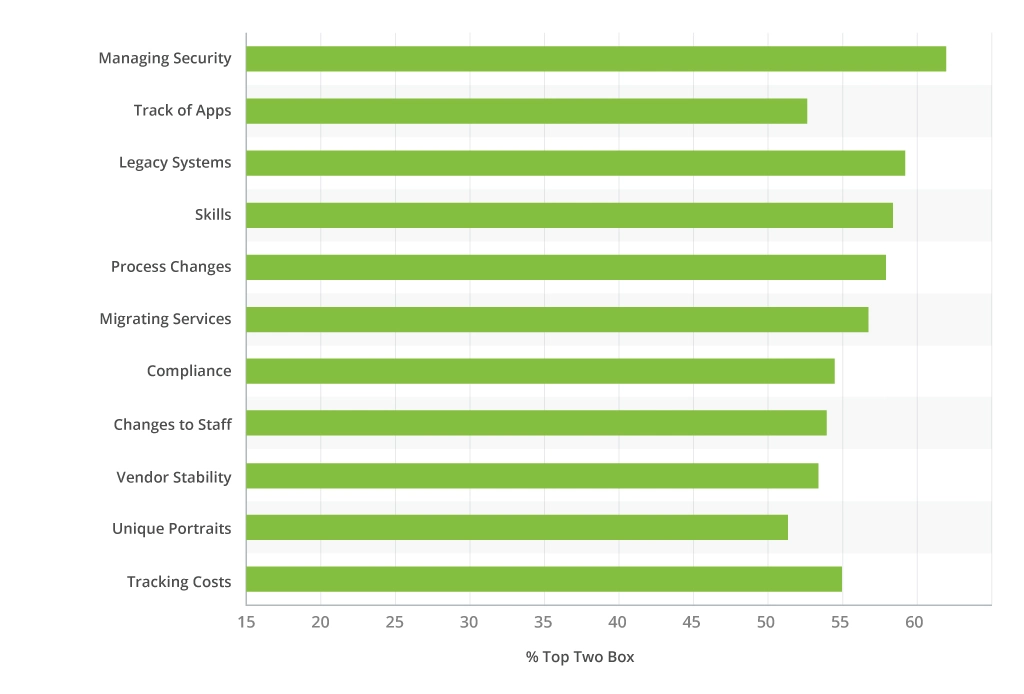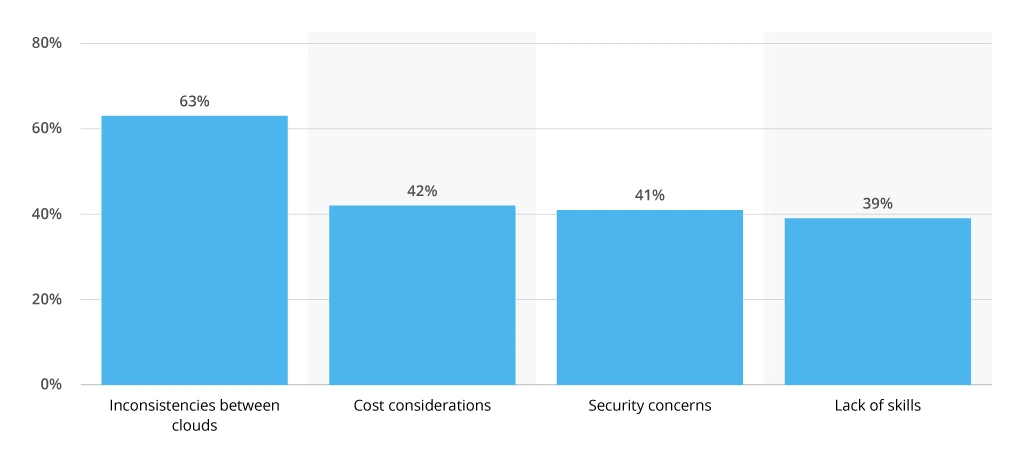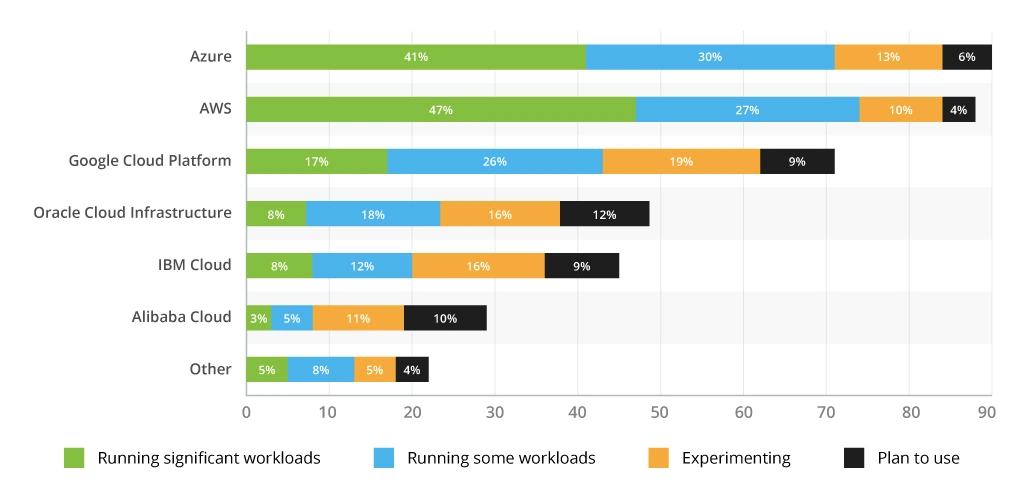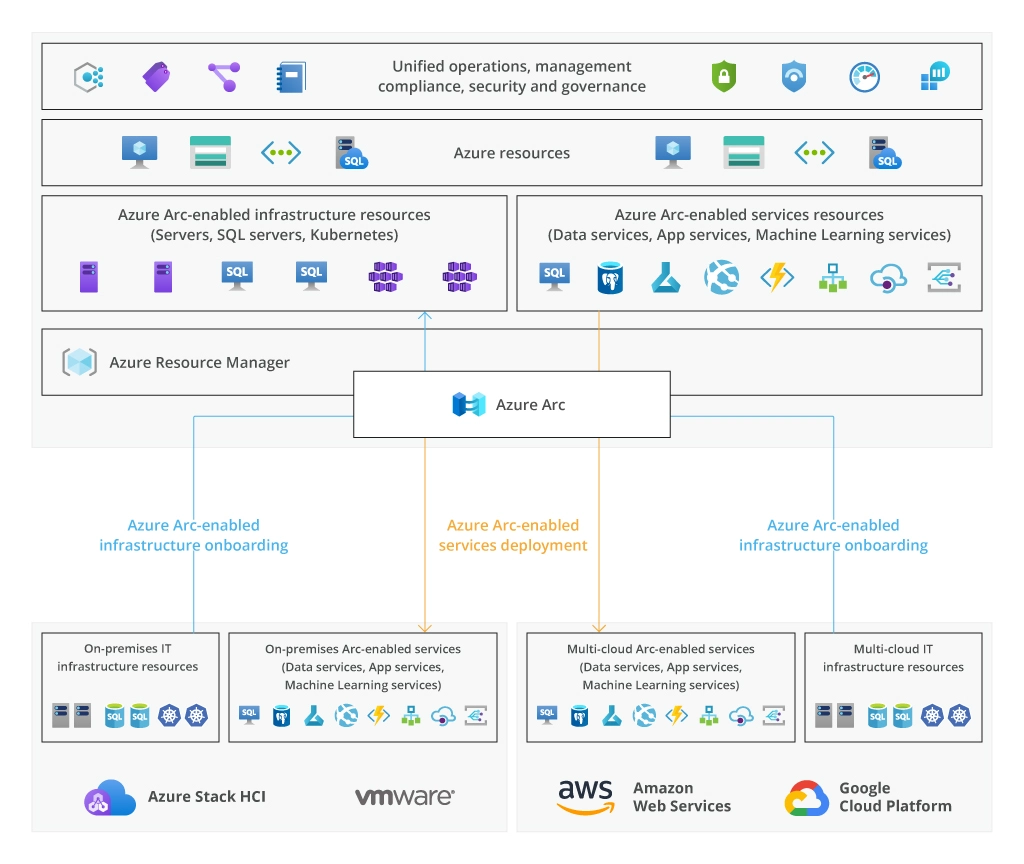Azure Arc: How to Make Multi-Cloud Management as Effective as Possible
Multi-cloud has long ago invaded the technology and business landscape. According to a recent report by Flexera, 87% of organizations opt for multi-cloud, seeing it as a key driver of innovation.
This is because multi-cloud enables companies to remain competitive in a constantly evolving business environment through benefits like scalability, efficiency, resource optimization, and reduced costs.
Multi-cloud Management Challenges
Any technology implementation has its risks and challenges, and multi-cloud is no exception. In an attempt to leverage the most sophisticated cloud features from different providers, decision-makers might find themselves among siloed solutions that are difficult to manage. This leads to related operational challenges that, without a proactive and holistic approach, threaten to diminish all potential benefits.
Security and Compliance
Maintaining optimal levels of cybersecurity is always demanding. When key assets like data and applications lie in the cloud, the task of ensuring rock-solid security becomes even more difficult.
This is due to the fact that companies have their own internal security policies that can’t always be easily adapted and applied to each particular cloud and its own respective security controls. Any inconsistency in implementation might lead to geographically distributed workloads becoming more prone to security breaches.
Managing compliance may also prove difficult in this respect. PCI, PII, GDPR, HIPAA, and other specific regulations should be fully met in different deployed clouds — to minimize the risk of hacking and data loss.
Cloud Management Complexity
Inadequate multi-cloud management can easily reverse all those sought-after advantages acquired by going multi-cloud. Workflow disruption, increased complexity in architecture and technology landscape development and management, poor user experience, inability to quickly adjust to service upgrades — the cost of insufficient oversight is real. To minimize these risks, you should coordinate every nuance your cloud partners have. With the optimal tool in place, you will be able to perform comprehensive, consistent management across on-premises and cloud environments, driving value-rich benefits.
However, with so many management tools available on the market, it’s difficult to make the right choice. Each tool has its benefits and gaps, so make sure to consult a reliable cloud expert to decide which provider is a perfect fit for your specific business needs.
Compatibility
As there are no specific interoperability standards in multi-cloud, each cloud provider takes a different approach to managing resources and services. When you’re on the multi-cloud side, be ready to deal with different vendor platforms and, as a result, fragmentation around infrastructure, services, APIs, database, CI/CD pipelines, network, security constructs, and other crucial aspects.
This challenge may even multiply, considering the fact that cloud services are constantly evolving and cloud providers tend to add new services and functions, introduce new integrations, disable some functionality, etc. As a result, you need to put in extra effort and money to implement relevant, timely adjustments to your cloud infrastructure.
Talent Shortage
The lack of highly specialized skills is another obstacle that can hold you back from innovating across multiple clouds. According to VMware, 39% of companies experience difficulties with this specific challenge, having to recruit and retain cloud experts with scarce skills. This always translates to extra effort, time, and money.
To be exact, enterprises struggle to fill the positions related to infrastructure engineering (48%), development platform operations (47%), coding (46%), and DevOps (46%). Also, cloud decision-makers say they need service partners to assist them with cloud migration (77%), app modernization (74%), and compliance (71%).
Cost Management
Unmanaged spending is another challenge revolving around multi-cloud. As you partner with multiple cloud providers, each of them having different governance standards and variations in operations, you may encounter difficulties with coherent cost management.
Conversely, full visibility into how you use your cloud services is a must for cost optimization. Consistent performance measurement, application dependencies monitoring, resource consumption analysis — every parameter matters in this case.
Azure Arc as a Problem-Solver
The majority of challenges described above are related to incoherent cloud management. Experts in all things cloud, Microsoft Azure does a lot to address this issue and help its customers uncover the full potential of their cloud environment, be it single- or multi-cloud. The Azure cloud platform tops the list of the most popular cloud providers for a reason.
Its specialized tool Azure Arc provides comprehensive management of an enterprise’s resources deployed anywhere — on-premises or, importantly, in other cloud providers. Azure Arc serves as a central hub that allows organizations to effectively operate multiple diverse technology solutions, standards, and service tiers, extending their Azure control plane into other public cloud platforms like AWS and Google Cloud.
Namely, with Azure Arc, you can seamlessly manage Windows and Linux physical servers as well as attach and configure Kubernetes clusters with various supported distributions. Azure data services can be run at the edge, on-premises, or in public clouds — with SQL Managed Instance, PostgreSQL, and other related services. You can also extend Azure services to SQL Server instances hosted outside of Azure. Moreover, Azure Arc empowers you to provision, manage, resize, and delete virtual machines both inside (VMware vSphere, Azure Stack HCI) and outside Azure.
Azure Arc Features and Functions
With Azure Arc on hand, you can drive both operational and business benefits by performing an array of key tasks.
Cloud-Native Apps Development
Azure provides all the necessary tools to build and modernize cloud-native apps and operate them anywhere. You can integrate Azure monitoring, security, and compliance functionality into your DevOps toolkit as well as run immediately with your existing tools. Azure Hybrid Benefit will help you optimize costs, and GitOps will accelerate your innovation.
Use case: If you’re a retailer who wants to deploy, configure, and manage your containerized applications across multiple locations, Azure Arc is here to help. With this tool, you can build cloud-native applications for each store, get a unified view over all your assets and inventory, as well as monitor the state and configurations of all applications.
Data Analysis and Management
Azure Arc enhances operational efficiencies as well as decreases management overhead and risk exposure through powerful data-driven capabilities, including:
- data collection, storage, and real-time analysis
- integrated security and governance tools for data
- consistent data and AI tools that enable automation
- managed machine learning add-on Azure Machine Learning.
Application Security
Security is another operation Azure Arc easily manages. With this tool, you’ll be able to meet the stringent security requirements while reducing expenses.
Cloud-based threat detection, central management of multiple resources, virtual machine lifecycle management, role-based access control, Azure Portal for governing disparate environments — Azure Arc delivers this and more.
Use case: Azure Arc enables robust application, user operations, and event logs monitoring, analysis, and visualization — helping companies significantly improve security and governance.
Regulatory Compliance
Azure Arc offers an array of infrastructure options — including Azure Stack HCI — to address residency and sovereignty needs. Azure Policy will ensure full cloud compliance, help avoid misconfigurations, and enable consistent resource governance, all while reducing the number of external approval processes.
Azure Arc-enabled Services
Although Azure Arc is a service by Microsoft, its usage goes far beyond. Underpinned by Azure Resource Manager, you can manage and secure your assets across all major public cloud providers and in-house IT environments — consolidating the information in a concise and useful format. The operations that Azure Resource Manager can easily perform include repeatable resource deployment, resource visualization to manage all possible dependencies, categorization for tasks like billing, as well as rock-solid access control and permission management.
Azure Automation can help you cut costs by automating time-consuming and error-prone tasks — including system updates orchestration and launch, configuration management across physical and virtual machines, as well as the monitoring of operating system resources inventory.
Microsoft Sentinel adds tangible business value by simplifying security operations with intelligent security analytics. With this mechanism, you can notably improve threat detection, investigation, and response — and do so while slashing costs by 48% and accelerating operations speed by 67% as compared to legacy security software.
By leveraging Azure Monitor, you get full control over all your applications, infrastructure, and networks — and, as a result, can maximize the performance and availability of your resources. Curated visualizations and reports, distributed tracing, logs monitoring, critical situation response — you name it, Azure Monitor has got your back.
Where Do We Go from Here?
In combination with various Microsoft tools, Azure Arc can indeed bring an array of tangible business benefits. However, as mentioned above, its implementation has certain challenges that an experienced Microsoft Azure expert like Infopulse is able to solve. With comprehensive Azure consulting services, full-fledged cloud migration, DevOps managed services, and Azure cloud security, Infopulse is here to address these and other business-specific needs.
![Azure Arc [main banner]](https://www.infopulse.com/uploads/media/banner-1920x528-azure-arc-multi-cloud-management.webp)







![Cloud Native vs. Cloud Agnostic [thumbnail]](/uploads/media/thumbnail-280x222-cloud-agnostic-vs-cloud-native-architecture-which-approach-to-choose.webp)
![Common Cloud Migration Challenges [thumbnail]](/uploads/media/common-cloud-migration-challenges to-overcome with-cloud-managed-services-2023-02-22_280x222.webp)
![Benefits of Cloud-Agnostic Strategy [thumbnail]](/uploads/media/thumbnail-280x222-cloud-agnostic-strategy-whats-in-and-how-to-act-to-get-tangible-business-value.webp)
![AWS Hybrid Cloud Solutions [thumbnail]](/uploads/media/thumbnail-280x222-hybrid-cloud-on-aws-benefits-and-use-cases.webp)




